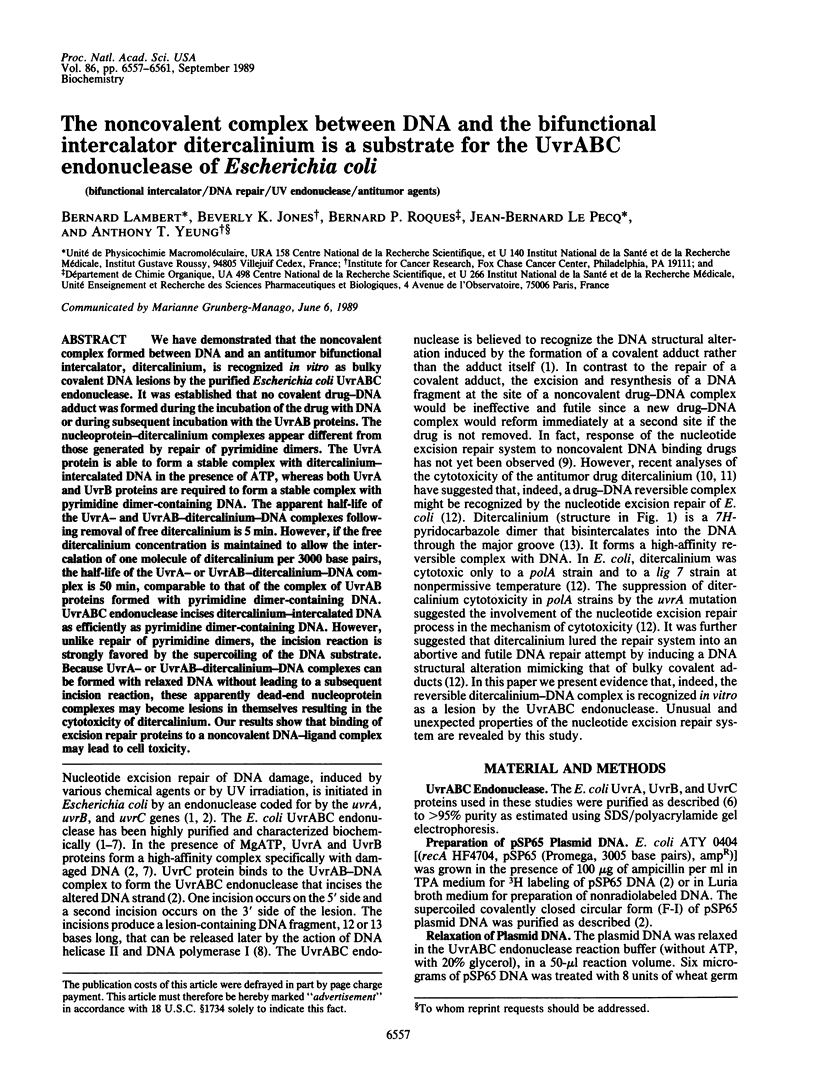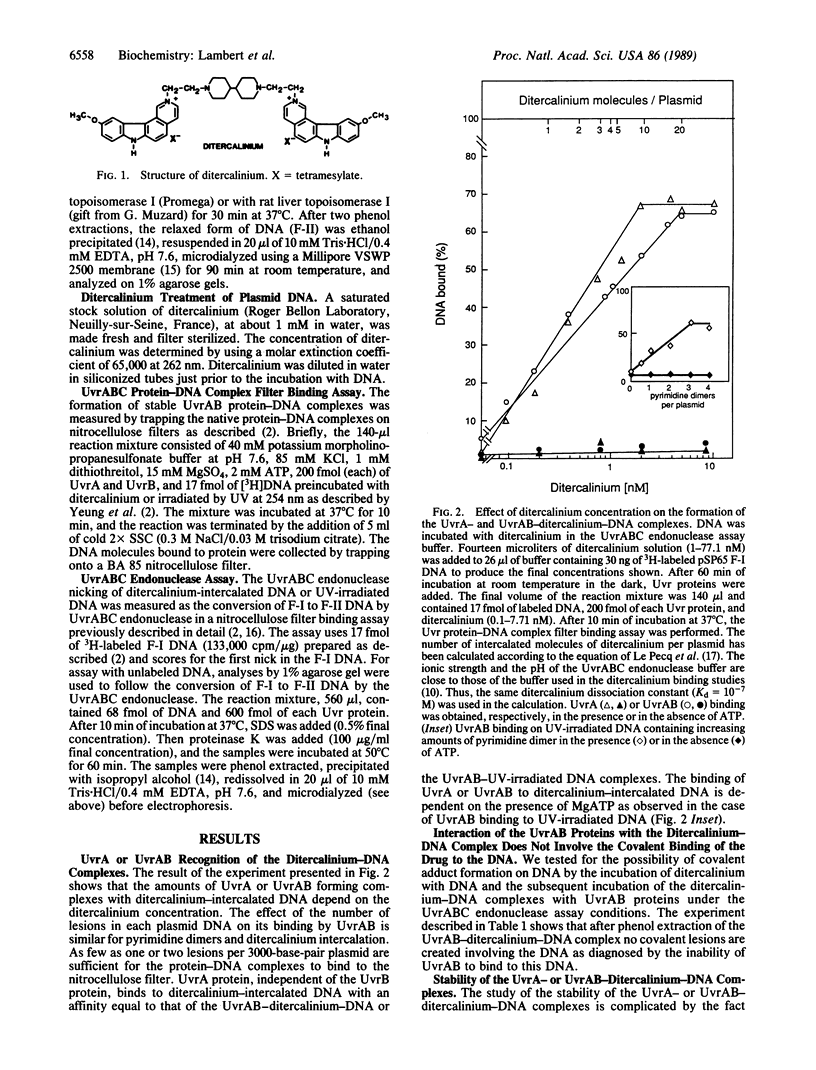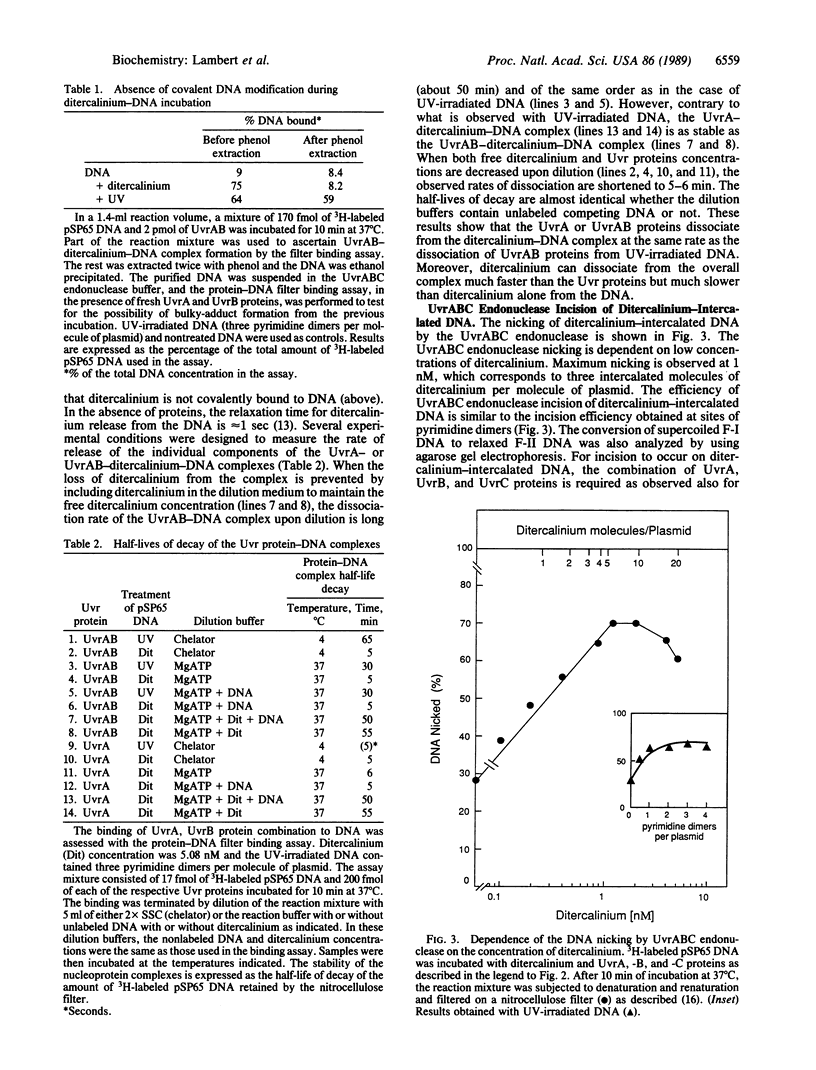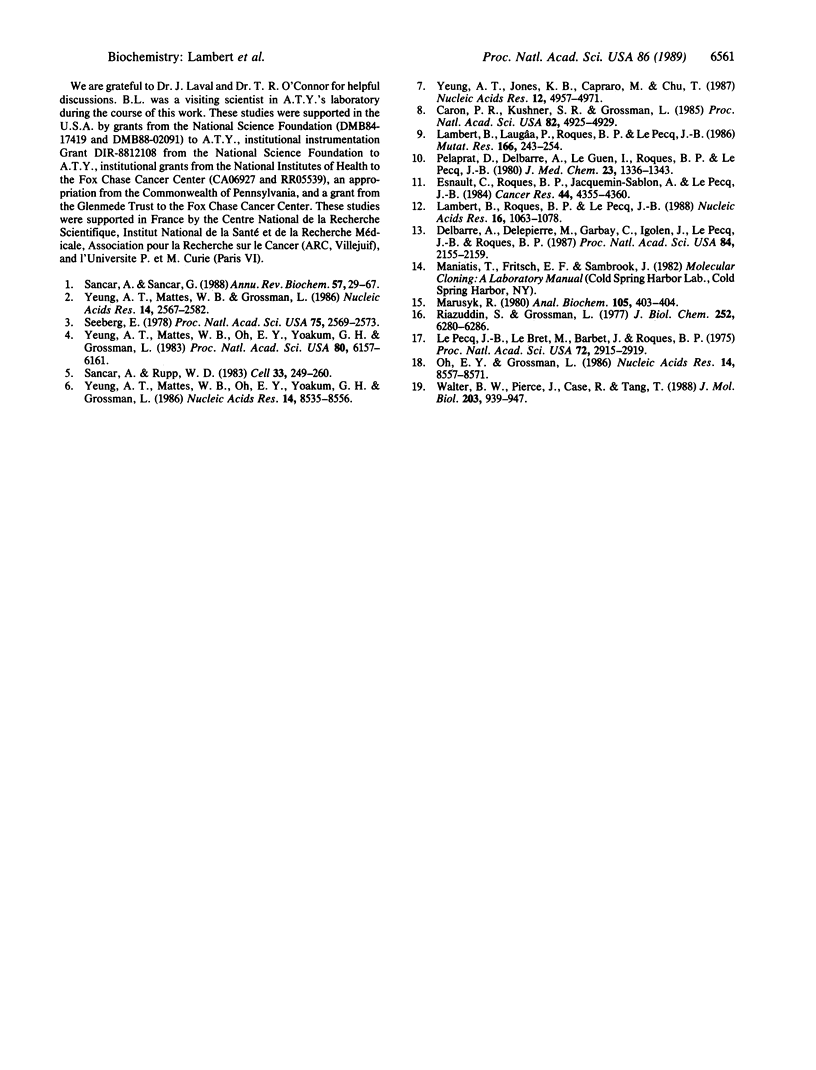Abstract
We have demonstrated that the noncovalent complex formed between DNA and an antitumor bifunctional intercalator, ditercalinium, is recognized in vitro as bulky covalent DNA lesions by the purified Escherichia coli UvrABC endonuclease. It was established that no covalent drug-DNA adduct was formed during the incubation of the drug with DNA or during subsequent incubation with the UvrAB proteins. The nucleoprotein-ditercalinium complexes appear different from those generated by repair of pyrimidine dimers. The UvrA protein is able to form a stable complex with ditercalinium-intercalated DNA in the presence of ATP, whereas both UvrA and UvrB proteins are required to form a stable complex with pyrimidine dimer-containing DNA. The apparent half-life of the UvrA- and UvrAB-ditercalinium-DNA complexes following removal of free ditercalinium is 5 min. However, if the free ditercalinium concentration is maintained to allow the intercalation of one molecule of ditercalinium per 3000 base pairs, the half-life of the UvrA- or UvrAB-ditercalinium-DNA complex is 50 min, comparable to that of the complex of UvrAB proteins formed with pyrimidine dimer-containing DNA. UvrABC endonuclease incises ditercalinium-intercalated DNA as efficiently as pyrimidine dimer-containing DNA. However, unlike repair of pyrimidine dimers, the incision reaction is strongly favored by the supercoiling of the DNA substrate. Because UvrA- or UvrAB-ditercalinium-DNA complexes can be formed with relaxed DNA without leading to a subsequent incision reaction, these apparently dead-end nucleoprotein complexes may become lesions in themselves resulting in the cytotoxicity of ditercalinium. Our results show that binding of excision repair proteins to a noncovalent DNA-ligand complex may lead to cell toxicity.
Full text
PDF




Images in this article
Selected References
These references are in PubMed. This may not be the complete list of references from this article.
- Caron P. R., Kushner S. R., Grossman L. Involvement of helicase II (uvrD gene product) and DNA polymerase I in excision mediated by the uvrABC protein complex. Proc Natl Acad Sci U S A. 1985 Aug;82(15):4925–4929. doi: 10.1073/pnas.82.15.4925. [DOI] [PMC free article] [PubMed] [Google Scholar]
- Delbarre A., Delepierre M., Garbay C., Igolen J., Le Pecq J. B., Roques B. P. Geometry of the antitumor drug ditercalinium bisintercalated into d(CpGpCpG)2 by 1H NMR. Proc Natl Acad Sci U S A. 1987 Apr;84(8):2155–2159. doi: 10.1073/pnas.84.8.2155. [DOI] [PMC free article] [PubMed] [Google Scholar]
- Esnault C., Roques B. P., Jacquemin-Sablon A., Le Pecq J. B. Effects of new antitumor bifunctional intercalators derived from 7H-pyridocarbazole on sensitive and resistant L 1210 cells. Cancer Res. 1984 Oct;44(10):4355–4360. [PubMed] [Google Scholar]
- Lambert B., Laugâa P., Roques B. P., le Pecq J. B. Cytotoxicity and SOS-inducing ability of ethidium and photoactivable analogs on E. coli ethidium-bromide-sensitive (Ebs) strains. Mutat Res. 1986 Nov;166(3):243–254. doi: 10.1016/0167-8817(86)90024-6. [DOI] [PubMed] [Google Scholar]
- Lambert B., Roques B. P., Le Pecq J. B. Induction of an abortive and futile DNA repair process in E. coli by the antitumor DNA bifunctional intercalator, ditercalinium: role in polA in death induction. Nucleic Acids Res. 1988 Feb 11;16(3):1063–1078. doi: 10.1093/nar/16.3.1063. [DOI] [PMC free article] [PubMed] [Google Scholar]
- Le Pecq J. B., Le Bret M., Barbet J., Roques B. DNA polyintercalating drugs: DNA binding of diacridine derivatives. Proc Natl Acad Sci U S A. 1975 Aug;72(8):2915–2919. doi: 10.1073/pnas.72.8.2915. [DOI] [PMC free article] [PubMed] [Google Scholar]
- Marusyk R., Sergeant A. A simple method for dialysis of small-volume samples. Anal Biochem. 1980 Jul 1;105(2):403–404. doi: 10.1016/0003-2697(80)90477-7. [DOI] [PubMed] [Google Scholar]
- Oh E. Y., Grossman L. The effect of Escherichia coli Uvr protein binding on the topology of supercoiled DNA. Nucleic Acids Res. 1986 Nov 11;14(21):8557–8571. doi: 10.1093/nar/14.21.8557. [DOI] [PMC free article] [PubMed] [Google Scholar]
- Pelaprat D., Delbarre A., Le Guen I., Roques B. P., Le Pecq J. B. DNA intercalating compounds as potential antitumor agents. 2. Preparation and properties of 7H-pyridocarbazole dimers. J Med Chem. 1980 Dec;23(12):1336–1343. doi: 10.1021/jm00186a010. [DOI] [PubMed] [Google Scholar]
- Riazuddin S., Grossman L. Micrococcus luteus correndonucleases. I. resolution and purification of two endonucleases specific for DNA containing pyrimidine dimers. J Biol Chem. 1977 Sep 25;252(18):6280–6286. [PubMed] [Google Scholar]
- Sancar A., Rupp W. D. A novel repair enzyme: UVRABC excision nuclease of Escherichia coli cuts a DNA strand on both sides of the damaged region. Cell. 1983 May;33(1):249–260. doi: 10.1016/0092-8674(83)90354-9. [DOI] [PubMed] [Google Scholar]
- Sancar A., Sancar G. B. DNA repair enzymes. Annu Rev Biochem. 1988;57:29–67. doi: 10.1146/annurev.bi.57.070188.000333. [DOI] [PubMed] [Google Scholar]
- Seeberg E. Reconstitution of an Escherichia coli repair endonuclease activity from the separated uvrA+ and uvrB+/uvrC+ gene products. Proc Natl Acad Sci U S A. 1978 Jun;75(6):2569–2573. doi: 10.1073/pnas.75.6.2569. [DOI] [PMC free article] [PubMed] [Google Scholar]
- Walter R. B., Pierce J., Case R., Tang M. S. Recognition of the DNA helix stabilizing anthramycin-N2 guanine adduct by UVRABC nuclease. J Mol Biol. 1988 Oct 20;203(4):939–947. doi: 10.1016/0022-2836(88)90119-2. [DOI] [PubMed] [Google Scholar]
- Yeung A. T., Jones B. K., Capraro M., Chu T. The repair of psoralen monoadducts by the Escherichia coli UvrABC endonuclease. Nucleic Acids Res. 1987 Jun 25;15(12):4957–4971. doi: 10.1093/nar/15.12.4957. [DOI] [PMC free article] [PubMed] [Google Scholar]
- Yeung A. T., Mattes W. B., Grossman L. Protein complexes formed during the incision reaction catalyzed by the Escherichia coli UvrABC endonuclease. Nucleic Acids Res. 1986 Mar 25;14(6):2567–2582. doi: 10.1093/nar/14.6.2567. [DOI] [PMC free article] [PubMed] [Google Scholar]
- Yeung A. T., Mattes W. B., Oh E. Y., Grossman L. Enzymatic properties of purified Escherichia coli uvrABC proteins. Proc Natl Acad Sci U S A. 1983 Oct;80(20):6157–6161. doi: 10.1073/pnas.80.20.6157. [DOI] [PMC free article] [PubMed] [Google Scholar]
- Yeung A. T., Mattes W. B., Oh E. Y., Yoakum G. H., Grossman L. The purification of the Escherichia coli UvrABC incision system. Nucleic Acids Res. 1986 Nov 11;14(21):8535–8556. doi: 10.1093/nar/14.21.8535. [DOI] [PMC free article] [PubMed] [Google Scholar]




